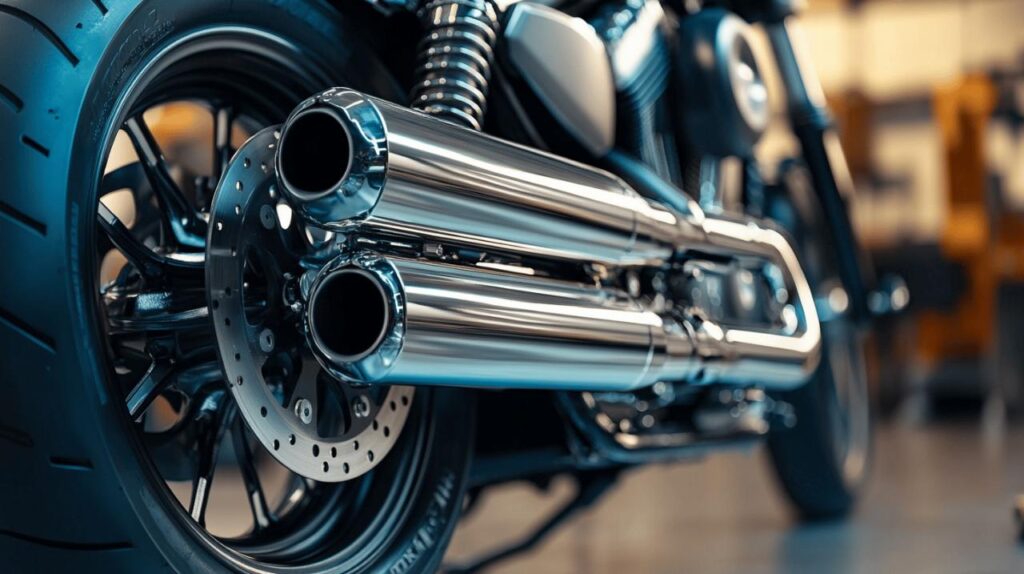For many motorcyclists, the rumble of an exhaust is part of the experience. Yet there are moments when a quieter ride becomes essential, whether to keep the peace with neighbours, avoid disturbing wildlife on country lanes, or simply to enjoy a more relaxed journey. Striking the right balance between performance and sound control need not be a compromise. With the right approach and equipment, it is entirely possible to reduce exhaust noise while maintaining the character and efficiency of your machine.
Understanding motorcycle exhaust noise and legal requirements
Why motorbike exhaust volume matters for riders
Exhaust volume is more than just a matter of personal preference. Prolonged exposure to loud exhaust notes can lead to hearing damage over time, particularly for riders who spend long hours on the road. Beyond the physical risks, excessive noise can draw unwanted attention and create friction with residents in built-up areas. A quieter exhaust system contributes to a more comfortable riding experience, allowing for better concentration and reducing fatigue on longer journeys. Furthermore, managing noise levels demonstrates consideration for others sharing the road and living nearby, fostering a more positive image of motorcycling as a whole.
Uk noise regulations and mot compliance standards
In the United Kingdom, motorcycles must adhere to strict noise regulations to pass the MOT test and remain road legal. The permissible noise levels vary depending on the age and type of the motorcycle, but exceeding these limits can result in fines or even having the vehicle taken off the road. Modern aftermarket exhaust systems are designed with these regulations in mind, ensuring compliance without sacrificing the character of the ride. When selecting an exhaust, it is crucial to verify that it meets UK standards and is certified for road use. This guarantees that the system will not only reduce noise but also keep your motorcycle within legal parameters during inspections.
Silencers and baffles: cost-effective noise reduction solutions
How exhaust silencers work to dampen sound waves
A silencer, or baffle, is one of the simplest and most effective ways to reduce exhaust noise. These devices work by disrupting and absorbing sound waves as they travel through the exhaust system. By creating a series of chambers and perforations, silencers break up the high-pressure sound waves and dissipate their energy before they exit the tailpipe. The result is a noticeably quieter exhaust note without the need for extensive modifications. Silencers are available in a variety of designs, from removable inserts to integrated units, making them a versatile option for riders seeking a straightforward solution to excessive noise.
Fitting compatible baffles to your existing system
One of the advantages of silencers is their compatibility with existing exhaust systems. Many aftermarket exhausts are designed to accept removable baffles, allowing riders to adjust the sound level to their preference. When selecting a baffle, it is essential to ensure it fits securely and does not obstruct exhaust flow, as this could negatively impact engine performance. Installation is typically straightforward, often requiring little more than basic tools and a few minutes of work. For those who prefer a quieter ride on certain occasions, removable baffles offer the flexibility to switch between a louder and more subdued exhaust note as needed.
Complete aftermarket exhaust systems for superior sound control
Advanced noise-reduction technology in modern exhaust designs
For riders seeking a more comprehensive approach to noise reduction, a complete aftermarket exhaust system can provide superior results. Modern systems incorporate advanced engineering techniques, such as multi-chamber designs and sound-absorbing materials, to minimise noise while optimising exhaust flow. Some manufacturers use materials like stainless steel and carbon fibre, which not only enhance durability but also contribute to noise dampening through their inherent properties. These systems are meticulously designed for specific bike models, ensuring a precise fit and maintaining the correct backpressure needed for optimal engine performance. The result is a quieter exhaust that does not compromise on power or efficiency.
Balancing performance, power output and weight considerations
When choosing an aftermarket exhaust system, it is important to consider the interplay between noise reduction, performance, and weight. A well-engineered system will reduce sound levels without restricting exhaust flow, preserving power output and throttle response. Some systems are also designed to be lighter than the original equipment, which can improve handling and reduce overall weight. However, achieving this balance requires careful selection and, in some cases, consultation with a qualified mechanic. Riders should look for systems that have been tested and certified for road use, as these will have been engineered to meet both legal standards and performance expectations. The investment in a quality exhaust system can pay dividends in comfort, compliance, and ride quality.
Materials and Construction: Choosing the Right Exhaust for Your Needs
Stainless steel versus alternative exhaust materials
The choice of material plays a significant role in the performance and longevity of an exhaust system. Stainless steel is a popular option due to its resistance to corrosion and its ability to withstand high temperatures. It also contributes to noise dampening through its density and construction. Carbon fibre, on the other hand, is lighter and offers excellent heat management properties, making it a favoured choice for performance-oriented riders. Some exhaust systems combine materials to leverage the benefits of each, such as a stainless steel core with a carbon fibre outer shell. The material chosen will affect not only the sound and weight of the exhaust but also its appearance and durability over time.
Selecting the Best Option for Your Riding Style and Budget
Selecting the right exhaust system requires careful consideration of your riding habits, aesthetic preferences, and financial constraints. For daily commuters and those who prioritise a peaceful ride, a system with robust noise-reduction features and MOT compliance is essential. Performance enthusiasts may prefer an exhaust that offers a balance of power optimisation and sound control, with customisable finishes to suit individual tastes. Budget is also a key factor, as prices can vary widely depending on the complexity of the system and the materials used. It is always advisable to consult with a qualified mechanic or specialist retailer to ensure the chosen exhaust is compatible with your motorcycle and meets your specific needs. By taking the time to research and select the right system, riders can enjoy quieter journeys without compromising on the performance and character of their machine.
Hearing protection and comfort enhancement through exhaust selection
Selecting the right motorcycle exhaust system isn't merely about aesthetics or raw power—it's fundamentally about safeguarding your wellbeing and enhancing the quality of every ride. Whilst the roar of an engine might seem integral to the motorcycling experience, prolonged exposure to excessive noise levels can have serious consequences for your hearing and overall comfort. Modern exhaust technology has evolved to offer riders a solution that balances performance optimisation with noise reduction, ensuring you can enjoy long journeys without compromising your health or disturbing those around you.
Quality exhaust systems designed with noise reduction in mind utilise advanced materials such as stainless steel and carbon fibre to dampen sound whilst maintaining optimal backpressure management. These materials not only reduce decibel levels but also ensure your motorcycle continues to perform efficiently. Crucially, reputable systems comply with UK noise regulations and MOT compliance standards, meaning you can ride with confidence knowing your modifications meet legal requirements. The investment in a quieter exhaust translates directly into improved comfort enhancement, allowing you to focus on the road ahead rather than battling fatigue from constant noise exposure.
How quieter exhausts reduce rider fatigue on long journeys
Extended rides can be physically and mentally demanding, and one of the most underestimated contributors to rider fatigue is continuous exposure to loud exhaust noise. The constant auditory assault doesn't just affect your ears—it impacts your entire nervous system, leading to increased stress levels, reduced concentration, and premature exhaustion. When you're battling against the relentless drone of an excessively loud exhaust, your body remains in a heightened state of alertness, preventing you from fully relaxing into the rhythm of the journey. This tension accumulates over hours, making even straightforward routes feel far more arduous than they ought to be.
By fitting motorcycle exhaust systems specifically engineered for noise reduction, you create a riding environment that's conducive to sustained concentration and comfort. Quieter exhausts allow you to hear crucial environmental sounds—other vehicles, warning signals, and road conditions—which enhances your situational awareness. The reduction in decibel levels also means your body expends less energy processing and filtering out unwanted noise, allowing you to arrive at your destination feeling refreshed rather than drained. Manufacturers now offer bike-specific design options that ensure optimal performance whilst delivering the acoustic comfort necessary for touring and long-distance riding. The improved heat management found in quality systems also contributes to rider comfort, as better thermal efficiency reduces the amount of heat radiating towards you during operation.
Protecting your hearing whilst maintaining the riding experience
Hearing damage from motorcycling is a genuine concern that many riders overlook until it's too late. Sustained exposure to noise levels above 85 decibels can cause permanent hearing loss, and traditional motorcycle exhausts can easily exceed 100 decibels—well into the danger zone. The insidious nature of noise-induced hearing damage is that it develops gradually, often going unnoticed until significant impairment has occurred. Protecting your hearing doesn't mean sacrificing the visceral connection to your machine; rather, it's about making informed choices that preserve your auditory health for decades of riding to come.
Modern quiet exhausts constructed from durable materials like stainless steel offer hearing protection without stripping away the character of your ride. These systems are engineered to maintain the satisfying mechanical feedback that makes motorcycling engaging whilst eliminating the harmful frequency ranges that cause auditory damage. The use of materials such as carbon fibre in premium systems provides additional sound dampening properties whilst keeping weight to a minimum, ensuring your bike's handling characteristics remain sharp. Many manufacturers now offer customisable finishes, allowing you to select an exhaust that not only protects your hearing but also complements your motorcycle's aesthetic perfectly.
When considering an upgrade, it's essential to choose systems that have been independently tested and certified to meet UK noise regulations. This ensures that your investment won't result in MOT compliance issues down the line. Quality exhaust manufacturers design their products to optimise the balance between performance optimisation and acoustic civility, using sophisticated backpressure management techniques to maintain power delivery whilst reducing output volume. The result is a motorcycle that's kinder to your ears, more considerate of your neighbours, and still delivers the responsive performance you expect. By prioritising hearing protection through thoughtful exhaust selection, you're not diminishing the riding experience—you're ensuring it can continue for many years to come.

